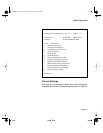
Overview
Page 9-5
normal port can belong to only one VLAN at a time. When a
normal port belongs to a particular VLAN, all frames received at
the port are classified to the VLAN of the port. The received
broadcast/Multicast packets, or received Unicast packets with
unknown destination, on this port, will be flooded only to ports
that belong to the same VLAN as the received port. To configure
a port to be a normal port, the tagging mode of the port must
be Disabled. See "Toggle VLAN Tagging" for details on
configuring a normal port.
VLAN Tagged (Expansion) Ports
Any port of the IntraSwitch can act as a tagged port (expansion
port). You can connect two compatible IntraSwitches via
tagged ports and thus communicate between VLANS on the two
switches. To make a port a tagged port, its tagging mode must
be Enabled. Frames transmitted on a tagged port carry the
VLAN ID in their tag field and frames received on a tagged port
are classified based on the VLAN ID in the frame's tag field. A
tagged port must be connected to another tagged port only
since all un-tagged frames on the tagged port are filtered. All
received unknown unicast and broadcast/multicast frames on a
tagged port are flooded to ports belonging to the VLAN to
which the received frames are classified.
See "Toggle VLAN Tagging" for details on enabling a tagged port
and "Overview: Using tagging to connect VLANs" for details on
mapping a tagged port to more than one VLAN.
The purpose of a tagged port is to provide connectivity
between two or more IntraSwitches such that they share some
or all of the system VLAN information between them. A
graphic example is shown in Figure 9-3.
▲ Important! The tagged port feature can
only be used to connect two Asanté
Switches.
6216M Book Page 5 Wednesday, January 27, 1999 5:26 PM


















